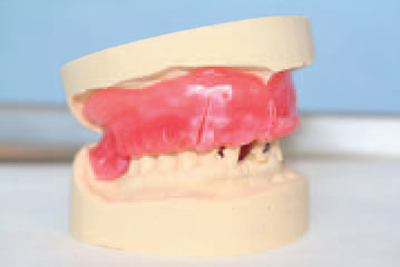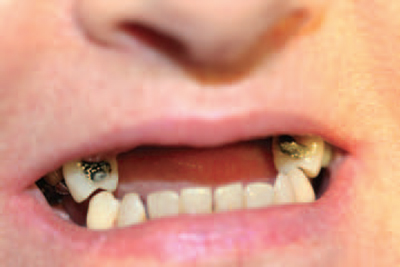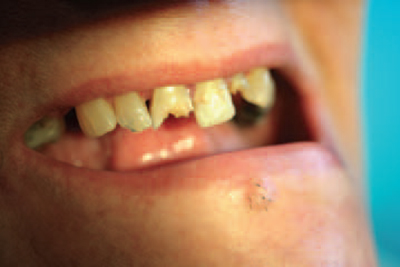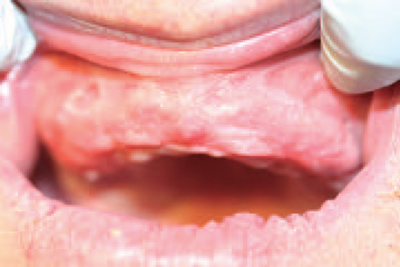SECTION 9
TOOTH REPLACEMENT WITH DENTURES

REASON FOR PROCEDURE
Tooth replacement is necessary for several reasons, but mainly to provide adequate masticatory function and to improve aesthetics (see Figure 9.1). The absence of one or several teeth may also allow overloading of those remaining, so that excessive tooth wear or even tooth fracture may occur (see Figure 9.2). When a tooth is missing, those on either side of it can collapse into the space remaining so that the occlusion is altered, or those in the opposite dental arch can overerupt into the space and cause unnatural wear of the remaining teeth.
Dentures are removable appliances made in several stages in a laboratory, and designed to replace just one or several teeth, or a full dental arch in an edentulous patient (see Figure 9.3). Unlike bridges, no tooth preparation is usually required for their construction as long as denture retention is available, and they can be removed from the patient’s oral cavity for cleaning as necessary.
They are retained in the mouth by a film of saliva between the oral soft tissues and the denture surface, which provides suction, as well as by the muscular support of the cheeks, lips and tongue. When the patient has some of his or her own teeth present, additional retention can be provided by using metal clasps incorporated in the denture design to grip these standing teeth.
Figure 9.1 Missing upper anterior teeth

Figure 9.2 Tooth wear with bruxism

Figure 9.3 Edentulous upper ridge

The base of the denture can be constructed using a pink or transparent acrylic material, or a very thin skeleton design of chrome–cobalt metal. The latter tends to be more comfortable to wear and more hygienic, as less soft tissue is covered, but usually requires the additional retention provided by clasps on suitably positioned standing teeth.
Those to be discussed are:
- Full or partial acrylic dentures
- Full or partial chrome dentures
- Immediate replacement dentures
FULL OR PARTIAL ACRYLIC DENTURES
Background information of procedure
Acrylic dentures are the most common type of denture provided, as they are cheaper and more easily constructed than chrome dentures. They are also more easily adjusted to fit as necessary, as well as being more amenable to relining and tooth addition as the patient’s oral cavity alters with time. However, they can fracture during normal usage in patients with heavy bites, or if they are inadvertently dropped whilst out of the mouth.
Nonetheless, acrylic dentures fulfil their necessary function of restoring the patient’s occlusion so that adequate mastication is possible, as well as improving appearance, especially when anterior teeth are missing.
Whether one tooth, several teeth or all of the dental arch is to be replaced, the construction procedure for acrylic dentures is basically the same.
Details of procedure
The denture construction normally takes up to five appointments, as each stage must be sent to a laboratory for the next stage to be constructed. When a partial denture is being made, the tooth shade is chosen to match that of the remaining standing teeth; however, when full dentures are being provided, any shade can be chosen, although the dentist will tend to advise a natural creamy shade rather than a more unnatural stark white colour.
Technique
- The dentist, nurse and patient wear personal protective equipment at each appointment
- The dental chair is kept upright for patient comfort, as well as to obtain the ideal position for the dentist to access the oral cavity for this procedure
- Initial impressions are taken in alginate material. They are sent to the laboratory for study model casting and for the construction of personalised impression trays and wax bite recording rims (see Figure 9.4)
- At the next appointment, accurate impressions are taken in one of the elastomeric impression materials available using the specially constructed impression trays, and the final decision on tooth shade and shape is made by the dentist and the patient
- Occlusal bite recording is carried out using the wax bite rims, so that a partially dentate patient has the same bite with the denture as without, and an edentulous patient can have his or her bite set at a comfortable position to allow speech and mastication, without the jaws being closed up or opened too much (see Figure 9.5)
- Wax bite rims will have been warmed and stuck together during the bite recording process and, once placed onto the study models, the technician can reproduce the patient’s bite accurately (see Figure 9.6)
- In complicated cases, the study models may be mounted onto an articulator at the laboratory
- At the next appointment, a waxed-up try-in of the denture is provided, with the teeth set at the previously recorded occlusion and in the shade and shape chosen (see Figure 9.7)
- The fit of the denture is assessed for accuracy, although it will feel slack to the patient as the wax base warms in the mouth
- The occlusion and aesthetics of the denture are assessed, and any minor adjustments can be carried out at the chairsid/>
Stay updated, free dental videos. Join our Telegram channel

VIDEdental - Online dental courses


